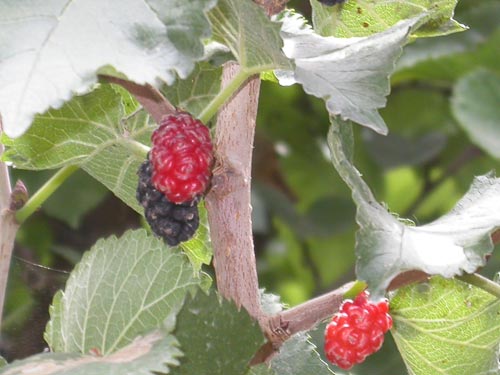Relatives
Morus nigra L. - Black mulberry.
Taxonomic position.
Family Moraceae Link, genus Morus L.Synonyms.
Morus laciniata Mill., M. siciliana Mill., M. scabra Marett (non Vidd.)Morphology and biology.
Latex-producing, dioecious plant. Deciduous tree, up to 15 m tall, with a broad, spreading crown. Leaves are large (15 x 12 cm), broadly ovate, asymmetrical, deeply cordiform at the base, shortly acuminate on top, obtusely dentate along the edge, whole or palmately lobate, dark green, leathery. Upper leaf surface is scabrous; lower leaf surface is covered with soft pubescence. Flowers are small, unattractive, clustered in catkin-like inflorescences. Fruits are large (up to 3 cm in diameter), black, glossy, sweetish sour, juicy, very tasty. Wind-pollinated and entomophilous. Ornitochore. Propagated by seed, layers or grafting. Seeds should be stored. Blossoms in April-June; bears fruit in June-July. Chromosome number: 2n=28.Distribution.
Occurs throughout Asia Minor, Iran, Afghanistan, the Balkans and Italy. Cultivated and wild in the Crimea (occasionally wild), the Caucasus (occasionally wild) and Central Asia (wild plants occur in Pamir-Altai-Hissar, Vakhsh and Darvaz Ranges, and Kopet Dagh (Sumbara river basin)). Originated in Iran and Afghanistan.Ecology.
Mesophyte. Shade-enduring and drought-resistant. Grows in rich soils but tolerates poor soils. Occurs on stony or turfy slopes and along river valleys in the lower and middle mountain zones.Utilization and economic value.
Food, industrial, ornamental and medicinal plant. Fruits are edible, consumed fresh, and used to make jams, confectionaries and stewed fruit. Leaves are used as feed for silkworms, but this results in coarser silk than when worms are fed white mulberry. Wood is very hard and good for woodcraft. Bast is used to produce cardboard, paper and rope.References:
Brezhnev D.D., Korovina O.N. 1981. Wild relatives of cultivated plants in the flora of the USSR. Leningrad: Kolos, pp. 117. (in Russian).Vulf E.V., Maleyeva O.F. 1969. Worldwide resources of useful plants. Reference book. Leningrad: Nauka, 563 p. (in Russian).


